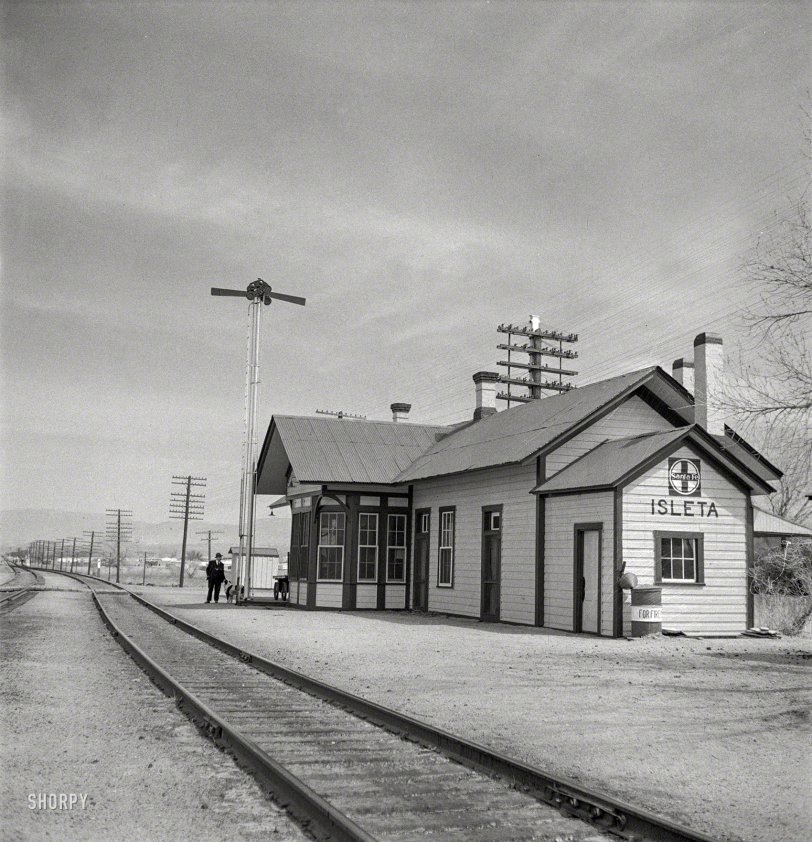


Framed or unframed, desk size to sofa size, printed by us in Arizona and Alabama since 2007. Explore now.
Shorpy is funded by you. Patreon contributors get an ad-free experience.
Learn more.

- Texas Flyer wanted
- Just a Year Too Soon
- WWII -- Replacing men with women at the railroad crossing.
- Yes, Icing
- You kids drive me nuts!
- NOT An Easy Job
- I wonder
- Just add window boxes
- Icing Platform?
- Indiana Harbor Belt abides
- Freezing haze
- Corrections (for those who care)
- C&NW at Nelson
- Fallen Flags
- A dangerous job made worse
- Water Stop
- Passenger trains have right of way over freights?
- Coal
- Never ceases to amaze me.
- Still chuggin' (in model form)
- Great shot
- Westerly Breeze
- For the men, a trapeze
- Tickled
- Sense of loneliness ...
- 2 cents
- Charm City
- What an Outrage
- Brighton Park
- Catenary Supports
Print Emporium
Unread Messages: 1943

March 1943. "Isleta, New Mexico. The Santa Fe depot. Horizontal arms on pole indicate a 'red beard,' that is a message is to be picked up by the train crew." Photo by Jack Delano for the Office of War Information. View full size.
Form 19 vs. Form 31 Train Orders
There were two commonplace forms used for Train Orders; Form 19 and Form 31.
A Form 19 order can be "hooped up" to a passing train, meaning that the order was fastened to a wooden hoop on a lightweight pole handle, and the crew of a passing train would catch the hoop on their arm, pull off the orders, and drop the hoop for re-use. Two hoops would be prepared, one to pass up to the locomotive and one to pass up to the caboose.
A Form 31 order must be "signed for", so the train must stop to receive it. The operator would keep a signed copy.
Train Orders are nicknamed "flimsies" because the pre-printed forms were on a translucent "onion skin" paper so that they could be read by holding them up to the glow of a kerosene lantern or a steam locomotive firebox, just slightly opened to let out some light. (The full glare of a hot firebox is dazzling - it would take away one's night vision for a while.)
Order Boards
The "messages" were Train Orders transmitted by the Train Dispatcher located usually in the division offices. Rules often specified that the signal remain at stop both ways until the engineer blew four short toots to "call for the board" . . . . if no orders, the operator would clear the signal in his direction, then reset to stop after the train had passed. This practice varied by company, but was a "fail-safe" to make sure the train received any orders. Most Western railroads abandoned the practice later, leaving the signals clear most of the time.
If there were orders some orders would be delivered on "the fly" but certain orders required signatures. Again, it varied by railroad.
E. W. Luke
Retired Train Dispatcher.
All Stop
In some locations, order boards were to be left in stop position. When a train approached, if there were no orders, the signal was cleared.
Sure not what it used to be
In 1986 an agreement was reached between the nation’s railroads and the Transportation Communication Employees Union which voided the exclusive right of operators to handle train orders. Operators had for a long time arranged for the written orders train crews were obliged to follow. Radios, computers and fax machines essentially rendered train orders moot, and hence the need for operators. Operators handling train orders today are very few and far between. Yours truly was one of them up until 1990, and I’m quite certain the control operator at the station I worked still handles them occasionally. After 1986 train dispatchers generally supervised train movements directly, issuing instructions to train crews by radio, often using track warrant and/or DTC operating authority.
Regarding steamghost’s remarks, a “31” order had to be signed for, a “19” order did not.
Multitasking
The indication also required (I think) the engineer to step into the office and sign for the orders.
It was also used in a not-by-the-book way by the station operator to slow down a train moving at high speed. Setting the indication would change the preceding track signal(s), telling the engineer to essentially approach at medium speed. This would give the operator extra time to transcribe or prepare train orders being given over telegraph or phone. Hopefully, the operator could reset the signal(s) before the train reached the station and pass the written orders to the trainmen on the fly as usual.
Beard??
I think that should be "red board", not "red beard". Signals were known as "boards"; the origin is pretty clear in this example.
Interesting that both arms are horizontal (red boards), indicating that the operator has train orders (the "message") for trains in both directions, eastbound and westbound.
Bad handwriting?
Red board, he probably meant to write. He's next to the line to El Paso, looking north; the line west to California curves away.
























On Shorpy:
Today’s Top 5